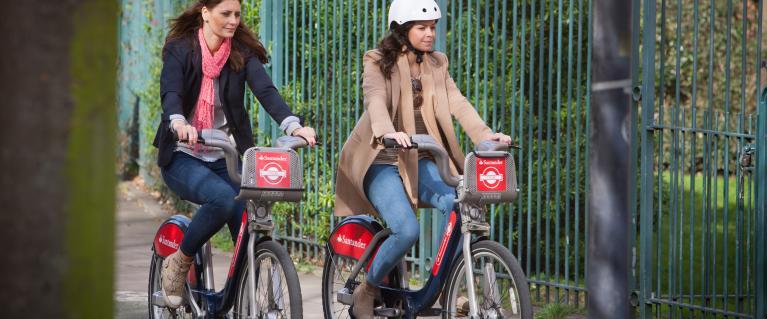
Transport and health
Transport can impact both positively and negatively on health and health inequalities. (Health inequalities are differences in health status occuring between different population groups.)
Transport can:
- provide access to employment and services
- provide opportunities to be physically active
- contribute positively to lively communities and a liveable city
On the other hand, transport can contribute to:
- poor air quality and noise
- road traffic collisions
- community severance
The Mayor’s Transport Strategy contains policies and proposals to tackle the negative effects of transport on health:
- improving safety, air quality, accessibility and the journey experience
- reducing noise
- providing opportunites for active travel
- promoting the use of sustainable modes of transport
Transport for London (TfL) implements the Mayor’s Transport Strategy. It is the main agency for transport services in London and runs London's buses, the Tube, the Docklands Light Railway (DLR), London Trams and the city’s major roads.
The Mayor and TfL also work in partnership with London’s boroughs, train operators, Department for Transport, the NHS and others.
Improving the health of Londoners: Transport Action Plan
Transport and street environments have an important part to play in improving people's health. This is because the main way that Londoners stay physically active is through using public transport.
Everyone needs to be active every day to prevent a wide range of illnesses including heart disease, depression and type 2 diabetes.
Recognising this, TfL has published its action plan for improving the health of Londoners through the transport system. This plan sets out 10 actions TfL will take to more explicitly recognise and demonstrate their role in improving health, including:
- supporting boroughs to improve the health of their populations through their transport plans and investment
- quantifying and where possible monetising the health impacts of our projects and policies
- urging central government to support their role in increasing the physical activity levels of Londoners
Health Impacts of Cars in London
London policy makers and public health professionals have asked for the evidence base for private car use and the impacts of cars on health in the city.
The Health Impacts of Cars in London report outlines the background to car travel in London including car ownership, the types of journey made by cars, the reasons given for car use and the health impacts of car use.
Transport and health factsheets
Concise factsheets provide key statistics and referenced information on transport and health topics in London.
Transport and health in London
We wanted to explore and compare the different impacts of air quality, road traffic injuries and physical activity. Academic research was commissioned, which involved setting up a range of hypothetical scenarios - these would show us the harms and benefits of different transport policies. Here are some of the key findings:
- the health benefits of physical activity from walking and cycling outweigh the harms of exposure to air pollution and road traffic injuries
- currently around 25 per cent of Londoners meet their minimum physical activity needs (150 minutes per week) through walking and cycling for transport alone. This is a significant contribution to overall activity levels in London
- the increased cycling expected by 2031 in the Mayor’s Transport Strategy could deliver health benefits of between 3,800 and 6,800 years of healthy life for the population of London. This is equivalent to nearly £250 million in monetary terms
- in theory Londoners could walk and cycle a lot more as part of their travel and if they did it would deliver over 61,500 years of health benefit each year. It would also mean that around 60% of Londoners could meet their physical activity needs through transport alone. This would deliver an economic benefit of nearly £2.2billion
Air quality guidance for public health professionals
Following the Health and Social Care Act, Health and Wellbeing Boards have been set up in each London borough. These boards publish a Health and Wellbeing Strategy, based on the health priorities identified in the borough’s Joint Strategic Needs Assessment.
We have produced guidance for public health professionals in every London borough on concentrations of air pollutants and how these affect health.
Select the relevent group below to view the Air Quality Report for your area.
- Barking and Dagenham - Air Quality report
- Barnet - Better Health guide - Air Quality report
- Bexley - Better Health g guide - Air Quality report
- Brent - Better Health guide - Air Quality report
- Bromley - Better Health guide - Air Quality report
- Camden - Better Health guide - Air Quality report
- City of London - Better Health guide - Air Quality report
- Croydon - Better Health guide - Air Quality report
- Ealing - Air Quality report
- Enfield -Air Quality report
- Greenwich - Air Quality report
- Hackney - Air Quality report
- Hammersmith and Fulham - Air Quality report
- Haringey - Air Quality report
- Havering - Air Quality report
- Harrow - Air Quality report
- Hillingdon - Air Quality report
- Hounslow - Air Quality report
We have also produced Better Environment, Better Health Guides for every London borough, offering tailored information for public health and other professionals on environmental factors that can impact on residents’ health, including green spaces, active travel, air quality and surface water flood risk.
Need a document on this page in an accessible format?
If you use assistive technology (such as a screen reader) and need a version of a PDF or other document on this page in a more accessible format, please get in touch via our online form and tell us which format you need.
It will also help us if you tell us which assistive technology you use. We’ll consider your request and get back to you in 5 working days.